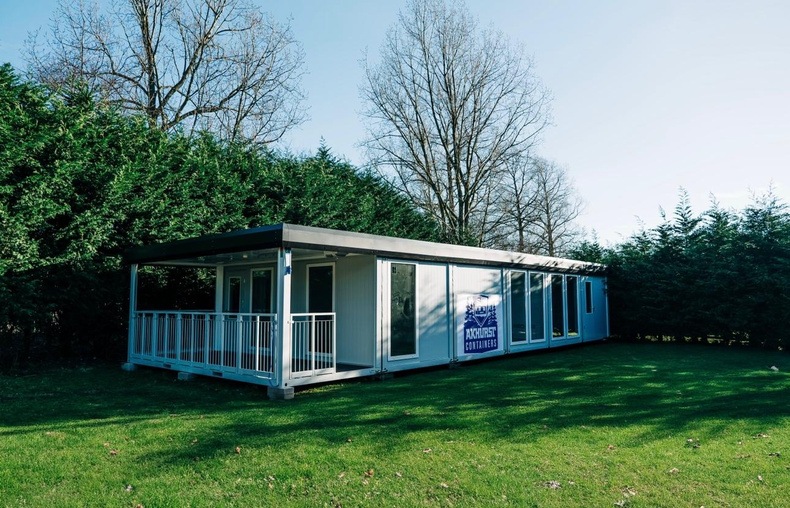The rise of modular container buildings: Revolutionising modern construction

Written by James Akhurst from Akhurst Containers
When you think of construction, what comes to mind? The endless noise, towering scaffolds, and a timeline that seems to stretch into eternity?
Modular container buildings are here to rewrite that narrative. They’re smart, sustainable, and efficient. faster, cheaper, and kinder to the planet—what’s not to love?
What are modular container buildings?
Imagine if shipping containers had a glow-up. Modular container buildings take their inspiration from these industrial giants, transforming them into flexible, reusable, and highly adaptable structures.
They’re the chameleons of the construction world—easy to move, redesign, or repurpose to meet changing needs, all while keeping waste to a minimum.
Why choose modular containers?
1 Sustainability
The construction industry has a bit of a reputation for being, well, messy. It’s responsible for mountains of waste and guzzles natural resources like there’s no tomorrow.
Enter modular containers, the tidy, resource-efficient alternative. Built to be reused and recycled, they help cut down on waste and extend the lifespan of materials. Who knew being eco-friendly could look so stylish?
2 Cost-effectiveness
Here’s a fun fact: modular container buildings are about 60-70 per cent cheaper than traditional structures. How? By speeding up construction and slashing labour costs. They’re like the efficient friend who gets everything done in half the time and still manages to save you money.
3 Durability
Designed to endure rough seas and salty air, these containers are basically the superheroes of construction. Rain, snow, wind? Bring it on.
They’re built tough enough to withstand all sorts of weather, and they don’t even ask for a cape.
4. Speed of construction
Think of modular containers as construction’s answer to instant coffee—quick, reliable, and surprisingly satisfying. Assembled in factories and delivered ready to stack, they can go from blueprint to building in a matter of weeks. Need an office, home, or café fast? Just add container.
Applications of modular container buildings
1 Residential spaces
Whether it’s a cosy tiny home or a sprawling modern masterpiece, these containers can do it all. With proper insulation, plumbing, and a little imagination, they’re every bit as comfortable as traditional homes—just a bit trendier.
2 Commercial ventures
From pop-up cafés to sleek urban offices, container-based commercial spaces are turning heads.
They’re portable, practical, and perfect for businesses that want to stand out. Bonus: you’ll never run out of people asking, “Is that really made from a container?”
3 Disaster relief
In emergencies, modular containers shine as quick, sturdy shelters. Stackable and easy to transport, they’re a lifesaver when speed and efficiency matter most—literally.
4 Educational and recreational facilities
Need a gym, library, or art studio? Containers are the answer. They’re practical, versatile, and a playground for creative design. Who knew maths lessons could happen in something this cool?
Real-life example: Absolute’s office expansion in Coleshill
At Akhurst Containers, we tackled a unique challenge for Absolute, a company in Coleshill.
They needed more office space but didn’t have the luxury of extra ground area. The solution? Six modular containers stacked on top of their existing storage units—like Lego, but on a grown-up scale.
The project gave them the space they needed without claiming any more land. It was quick, sustainable, and proof that even in construction, thinking vertically pays off.
The eco-friendly advantage
Modular container buildings are a gift to the planet—and to your conscience. If you no longer need the structure, you don’t have to tear it down.
Just move it, repurpose it, or turn it into something entirely new. It’s the Marie Kondo of construction: tidy, efficient, and sparks joy.
Factory-built containers also mean less noise and disruption on-site, so your neighbours will thank you. Companies like Absolute are showing that building green doesn’t mean sacrificing style or functionality—it just means being smarter about it.
Endless design possibilities
If you think modular containers are just metal boxes, think again. Architects and designers have transformed these blank canvases into stunning spaces with rooftop gardens, expansive windows, and sleek modern interiors. Who says practicality can’t be pretty?
Challenges to consider
Of course, no innovation comes without its quirks:
1 Insulation: Steel might be strong, but it’s not great at keeping you cosy. Quality insulation is a must.
2 Zoning laws: Some local councils might raise an eyebrow at container buildings. Do your homework to avoid a bureaucratic headache.
3 Structural modifications: Cutting into a container isn’t a DIY job. You’ll need an expert to keep things safe and sound—this is not the time to channel your inner amateur welder. (That’s us - Akhurst Containers)
The future of container architecture
Modular container buildings are more than just a passing trend; they’re a blueprint for smarter, greener construction.
As urban spaces grow tighter and sustainability takes centre stage, these structures offer a practical, stylish solution that doesn’t cost the earth—literally.
With their versatility and eco-friendly appeal, container buildings are proving that you don’t have to choose between functionality and flair.
Next time you pass one, imagine the possibilities—a buzzing café, a thriving business, or even your dream home.
Final thoughts
Modular container buildings are changing how we think about construction. They’re fast, affordable, and kinder to the planet—essentially the overachiever of the building world. By reimagining what’s possible, we’re creating spaces that are as adaptable as they are sustainable.
Who knew shipping containers could hold so much potential?
